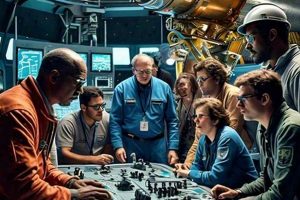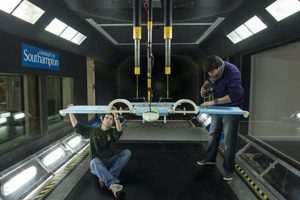Distinct areas of specialization exist within the broader field dedicated to designing, developing, and testing aircraft and spacecraft. These focused domains allow engineers to cultivate expertise in specific aspects of flight, both within and beyond Earth’s atmosphere. Examples include the study of aerodynamics, propulsion systems, structural mechanics, and control systems integral to the performance and safety of aerial and space vehicles.
Focused expertise offers several advantages. Specialization accelerates innovation by enabling engineers to deeply investigate particular challenges and develop advanced solutions. Concentrated knowledge contributes significantly to improved efficiency, safety, and performance in aerospace vehicles. Historically, such dedicated pathways have fostered groundbreaking advancements, from the development of jet propulsion to the exploration of distant planets.
The subsequent sections will explore key domains within this multifaceted engineering discipline. These include areas focusing on the motion of air and other gases, the systems that power flight, the materials and designs that provide structural integrity, and the automated control mechanisms that govern vehicle operation.
The following recommendations provide insight into strategically approaching focused areas within aerospace engineering. Consideration of these points can aid in the effective pursuit of specialized knowledge and the advancement of innovative solutions.
Tip 1: Establish a Strong Foundation in Core Principles: A comprehensive understanding of fundamental engineering principles, including mathematics, physics, and computer science, is essential before specializing. This foundational knowledge provides the necessary framework for comprehending advanced concepts within specific areas.
Tip 2: Identify Areas of Genuine Interest: Exploring individual passions within the field can lead to more fulfilling and productive careers. Research various disciplines, such as aerodynamics, propulsion, or astrodynamics, to determine which aligns best with personal aptitude and enthusiasm.
Tip 3: Pursue Targeted Education and Training: Seek out specialized coursework, advanced degrees, and professional certifications relevant to the chosen domain. This focused educational path provides in-depth knowledge and practical skills necessary for success.
Tip 4: Gain Practical Experience Through Internships and Research: Hands-on experience is invaluable for solidifying theoretical knowledge. Internships, research opportunities, and participation in aerospace projects provide exposure to real-world challenges and collaborative environments.
Tip 5: Cultivate Interdisciplinary Collaboration: While specialization is important, aerospace projects often require collaboration across various disciplines. Developing strong communication and teamwork skills is crucial for effectively integrating individual expertise with broader team objectives.
Tip 6: Stay Abreast of Technological Advancements: The aerospace field is constantly evolving. Continuous learning through industry publications, conferences, and professional development opportunities is essential for remaining current with the latest technologies and methodologies.
Tip 7: Consider the Evolving Landscape of the Aerospace Industry: Factors such as sustainability, space exploration, and autonomous systems are shaping the future of the industry. Aligning specialization with these emerging trends can increase career opportunities and contribute to groundbreaking innovation.
Strategic preparation, dedicated training, and a commitment to continuous learning are crucial for successful navigation and contribution within focused sectors. These elements position individuals to drive innovation and address the complex challenges within aerospace engineering.
The subsequent section will offer resources to further explore this vast field.
1. Aerodynamics
Aerodynamics, a cornerstone of aerospace engineering, focuses on the interaction of air and other gaseous fluids with solid objects. Its application is critical to the design and performance of aircraft, spacecraft, and related technologies. The principles of aerodynamics govern lift generation, drag reduction, and overall flight stability, influencing vehicle efficiency and maneuverability.
- Lift Generation
Lift is the force that counteracts gravity, allowing aircraft to remain airborne. Aerodynamic design optimizes wing shapes to create pressure differentials, generating upward lift. For example, airfoil designs on aircraft wings are carefully engineered to produce lower pressure above the wing and higher pressure below, resulting in a net upward force. This is a fundamental aspect of aerodynamic design within the field.
- Drag Reduction
Drag is the force that opposes motion through a fluid. Minimizing drag is essential for improving fuel efficiency and maximizing speed. Techniques such as streamlining, use of smooth surface materials, and implementation of winglets are employed to reduce drag. Aircraft manufacturers invest heavily in aerodynamic testing and computational fluid dynamics (CFD) to optimize designs for minimal drag coefficients.
- Flight Stability and Control
Aerodynamic principles govern the stability and controllability of aircraft. Control surfaces, such as ailerons, elevators, and rudders, manipulate airflow to adjust an aircraft’s attitude and direction. Aerodynamic analysis ensures that these surfaces are effective and that the aircraft exhibits stable flight characteristics. Without proper aerodynamic considerations, aircraft would be unstable and uncontrollable.
- Supersonic and Hypersonic Aerodynamics
At supersonic and hypersonic speeds, the behavior of air becomes significantly more complex due to the formation of shockwaves. Specialized aerodynamic designs are required for vehicles operating at these speeds, such as supersonic jets and reentry spacecraft. Understanding shockwave formation, heat transfer, and pressure distributions is crucial for the successful design and operation of hypersonic vehicles.
The principles and applications of aerodynamics are intricately linked to the design, development, and performance of aerospace vehicles. Its relevance extends across a wide range of sub-disciplines, influencing everything from wing design to spacecraft reentry profiles. The continued advancement of aerodynamic knowledge remains essential for progress within the broader field of aerospace engineering.
2. Propulsion Systems
Propulsion systems represent a critical constituent within aerospace engineering, directly enabling flight and space travel. These systems generate the thrust necessary to overcome drag and gravity, propelling vehicles through the atmosphere and beyond. The selection and design of a propulsion system are fundamentally linked to the mission requirements, vehicle type, and operational environment, illustrating the interconnectedness within aerospace engineering. The development of increasingly efficient and powerful propulsion methods has consistently expanded the operational boundaries of aerospace vehicles. For example, the transition from piston engines to jet engines drastically increased aircraft speed and altitude capabilities, while rocket propulsion enabled human spaceflight.
The design and integration of propulsion systems demand expertise across multiple engineering disciplines. Thermodynamics, fluid mechanics, combustion, and materials science are all critical considerations in propulsion system development. Engineers specializing in this area must consider factors such as fuel efficiency, thrust-to-weight ratio, reliability, and environmental impact. Practical applications range from designing high-bypass turbofan engines for commercial airliners to developing advanced rocket engines for interplanetary missions. Advancements in areas such as electric propulsion, scramjets, and fusion propulsion continue to push the boundaries of what is possible in space exploration and high-speed flight.
In summary, propulsion systems are integral to aerospace engineering, representing a complex intersection of scientific principles and engineering practices. Progress in propulsion directly translates to enhanced vehicle performance, expanded mission capabilities, and continued exploration of air and space. The continuous pursuit of innovation in propulsion technology remains a driving force behind advancements in the broader aerospace field. The ongoing evolution of propulsion systems poses challenges related to efficiency, sustainability, and performance, demanding interdisciplinary approaches and specialized expertise within the diverse landscape of aerospace engineering.
3. Structural Mechanics
Structural mechanics, as an integral branch within aerospace engineering, focuses on analyzing and predicting the behavior of aerospace vehicle structures under various loads and environmental conditions. Its primary objective is to ensure the structural integrity, safety, and reliability of aircraft and spacecraft throughout their operational lifespan, providing a framework for design and optimization across varied subfields.
- Stress and Strain Analysis
This involves determining the internal stresses and strains within structural components subjected to external forces. Finite element analysis (FEA) is commonly employed to simulate complex stress distributions. For instance, during aircraft design, FEA models are used to analyze stress concentrations around fastener holes in the fuselage to prevent premature fatigue failure. Understanding stress and strain is paramount for validating structural integrity during flight or launch conditions.
- Material Selection and Characterization
Choosing appropriate materials with specific strength, stiffness, and weight characteristics is vital. Aerospace structures often utilize lightweight composites, aluminum alloys, and titanium. Material testing and characterization are performed to determine mechanical properties such as yield strength, tensile strength, and fatigue resistance. The selection of a composite material for an aircraft wing requires consideration of its strength-to-weight ratio and resistance to environmental degradation.
- Structural Stability and Buckling
Structural stability refers to the ability of a structure to withstand compressive loads without undergoing catastrophic buckling. Buckling analysis is performed to determine the critical load at which a structure becomes unstable. Aircraft fuselages, for example, are designed with stiffeners to prevent buckling under aerodynamic pressure loads. Accurate prediction of buckling behavior is essential for ensuring structural integrity and preventing catastrophic failure.
- Fatigue and Fracture Mechanics
Fatigue and fracture mechanics address the gradual degradation of structural components due to cyclic loading. Fatigue analysis is used to predict the fatigue life of critical components, while fracture mechanics assesses the potential for crack propagation. Regular inspections of aircraft structures are conducted to detect fatigue cracks before they reach a critical size. This is important to prolong the life cycle.
The principles and methodologies of structural mechanics are essential for ensuring the safety and reliability of aerospace vehicles. These principles permeate across all relevant specializations, from aircraft design to spacecraft development. Proper analysis and design in this area directly translate to improved performance, extended operational life, and enhanced safety for aerospace systems.
4. Control Engineering
Control engineering plays a pivotal role within aerospace engineering, providing the methodologies and technologies necessary to govern the behavior of complex aerospace systems. The inherent instability and demanding operational environments of aircraft and spacecraft necessitate sophisticated control strategies to ensure safe, efficient, and reliable performance. Control systems are responsible for maintaining stability, executing desired maneuvers, and mitigating the effects of disturbances, thus forming an indispensable component of modern aerospace vehicles.
The practical application of control engineering is evident across a broad spectrum of aerospace systems. Flight control systems in aircraft, for instance, automatically adjust control surfaces to maintain desired altitude, heading, and speed, enabling pilots to manage complex flight profiles with precision. In spacecraft, attitude control systems use reaction wheels, thrusters, or magnetic torquers to orient the vehicle in space, facilitating precise pointing for scientific observations or communication with Earth. Furthermore, guidance and navigation systems rely on advanced control algorithms to guide vehicles along predetermined trajectories, ensuring accurate delivery of payloads or successful completion of missions. Without these control systems, piloted and autonomous aerospace vehicles cannot function effectively.
Advancements in control engineering are directly linked to the continued progress of aerospace technology. Adaptive control techniques, for example, allow systems to automatically adjust their parameters in response to changing conditions or uncertainties, enhancing robustness and performance. Model predictive control (MPC) enables the optimization of control actions over a future time horizon, allowing for improved fuel efficiency and trajectory planning. As aerospace systems become increasingly complex and autonomous, the importance of control engineering will only continue to grow, driving further innovation in areas such as artificial intelligence, robotics, and advanced sensor technologies.
5. Astrodynamics
Astrodynamics, a critical area within aerospace engineering, applies principles of celestial mechanics to the design and analysis of spacecraft trajectories. It is essential for mission planning, satellite operations, and space exploration, providing the mathematical framework for navigating the complexities of orbital mechanics within the larger context of aerospace engineering. Astrodynamics ensures the efficient and safe maneuvering of vehicles within the Earth-Moon system, interplanetary space, and beyond.
- Orbit Determination and Prediction
Accurate determination and prediction of satellite orbits are fundamental to astrodynamics. This involves using observational data and mathematical models to calculate the current and future positions of spacecraft. Orbit determination is crucial for collision avoidance, precise pointing for Earth observation, and reliable communication links. For example, tracking satellites after launch to refine their orbital parameters ensures proper placement and operational efficiency. Predictive models account for gravitational perturbations, atmospheric drag, and solar radiation pressure, all of which impact long-term orbital stability.
- Trajectory Design and Optimization
Designing optimal trajectories for spacecraft missions is a primary focus of astrodynamics. This involves calculating fuel-efficient paths for interplanetary travel, rendezvous maneuvers, and orbital transfers. Trajectory optimization techniques, such as Lambert’s problem solutions and low-thrust trajectory design, minimize fuel consumption and mission duration. For instance, designing a trajectory for a Mars mission involves careful consideration of launch windows, planetary alignments, and gravitational assists to reduce propellant requirements. Optimal trajectories are essential for maximizing mission success while minimizing cost.
- Orbital Maneuvering and Control
Orbital maneuvering and control techniques enable spacecraft to adjust their orbits and maintain desired positions in space. This involves using onboard propulsion systems to perform maneuvers such as orbit raising, inclination changes, and station-keeping. Precise control is vital for maintaining satellite constellations, performing rendezvous operations, and executing deorbiting maneuvers. For example, communication satellites require precise station-keeping maneuvers to maintain their assigned positions in geostationary orbit. Accurate calculations and control strategies are critical for achieving mission objectives.
- Interplanetary Mission Design
Astrodynamics plays a critical role in designing interplanetary missions, which involve navigating spacecraft through the solar system to reach distant planets and celestial bodies. This requires precise calculations of launch windows, trajectory optimization, and gravitational assists. Mission designers must account for the complex gravitational interactions of multiple celestial bodies to plan efficient and reliable routes. For instance, the Voyager missions utilized gravitational assists from Jupiter and Saturn to reach Uranus and Neptune. Effective interplanetary mission design relies heavily on the principles of astrodynamics.
These facets highlight the critical role of astrodynamics within the broader field of aerospace engineering. From ensuring the precise positioning of Earth-orbiting satellites to enabling ambitious interplanetary missions, astrodynamics provides the theoretical and practical tools necessary for navigating the challenges of space. Continued advancements in astrodynamics are essential for future space exploration and the development of innovative aerospace technologies.
Frequently Asked Questions
The following section addresses common inquiries related to focused areas within aerospace engineering. These questions and answers aim to provide clarity on the nature, scope, and significance of specialization in this multifaceted field.
Question 1: What constitutes a “subfield” within aerospace engineering?
A subfield represents a specialized area of knowledge and expertise within the broader discipline. It involves focused study and practice in a particular aspect of aerospace vehicle design, development, or operation. Examples include aerodynamics, propulsion systems, and structural mechanics.
Question 2: Why is specialization important in aerospace engineering?
Specialization allows engineers to develop in-depth knowledge and skills in a particular area, fostering innovation and improving efficiency. The complexity of aerospace systems necessitates specialized expertise to address specific challenges and contribute to advancements in technology.
Question 3: How does one choose an area of specialization?
Selection of a specialized area should be based on individual interests, aptitudes, and career goals. Exploration of various disciplines, research opportunities, and practical experiences can aid in identifying a suitable path.
Question 4: Is it possible to switch between different specializations within aerospace engineering?
While not always easy, transitioning between specializations is possible, particularly early in one’s career. This often requires additional education, training, or experience to acquire the necessary expertise in the new area.
Question 5: What are the long-term career prospects associated with specific specializations?
Career prospects vary depending on the specific area of specialization and the evolving needs of the aerospace industry. Emerging trends such as sustainable aviation, space exploration, and autonomous systems may create increased demand for certain specialized skills.
Question 6: How do specializations relate to the design and development of a complete aerospace vehicle?
Specializations contribute to specific aspects of vehicle design and development. Aerodynamics specialists focus on the vehicle’s shape, drag, and lift. Propulsion engineers handle the power systems, while structural engineers are responsible for the body. Integration of these aspects is vital for creating a successful vehicle.
In summary, focused expertise is integral to addressing the complex challenges and fostering innovation within aerospace engineering. Strategic specialization, coupled with continuous learning, is essential for contributing to advancements in the field.
The following section offers resources to further explore this vast field.
Conclusion
The preceding discussion has elucidated key aspects of aerospace engineering subfields, emphasizing their individual significance and collective contribution to the broader discipline. These focused areas of expertise, ranging from aerodynamics and propulsion to structural mechanics, control engineering, and astrodynamics, are indispensable for the design, development, and operation of advanced aerospace vehicles. Each subfield requires specialized knowledge and skills, fostering innovation and enabling progress in the exploration of both air and space.
The future of aerospace engineering hinges on continued specialization and the integration of diverse expertise. Addressing emerging challenges related to sustainable aviation, space exploration, and autonomous systems demands a concerted effort across various subfields. Continued research, education, and collaboration are essential to pushing the boundaries of aerospace technology and realizing the full potential of aerospace engineering for the benefit of society.







